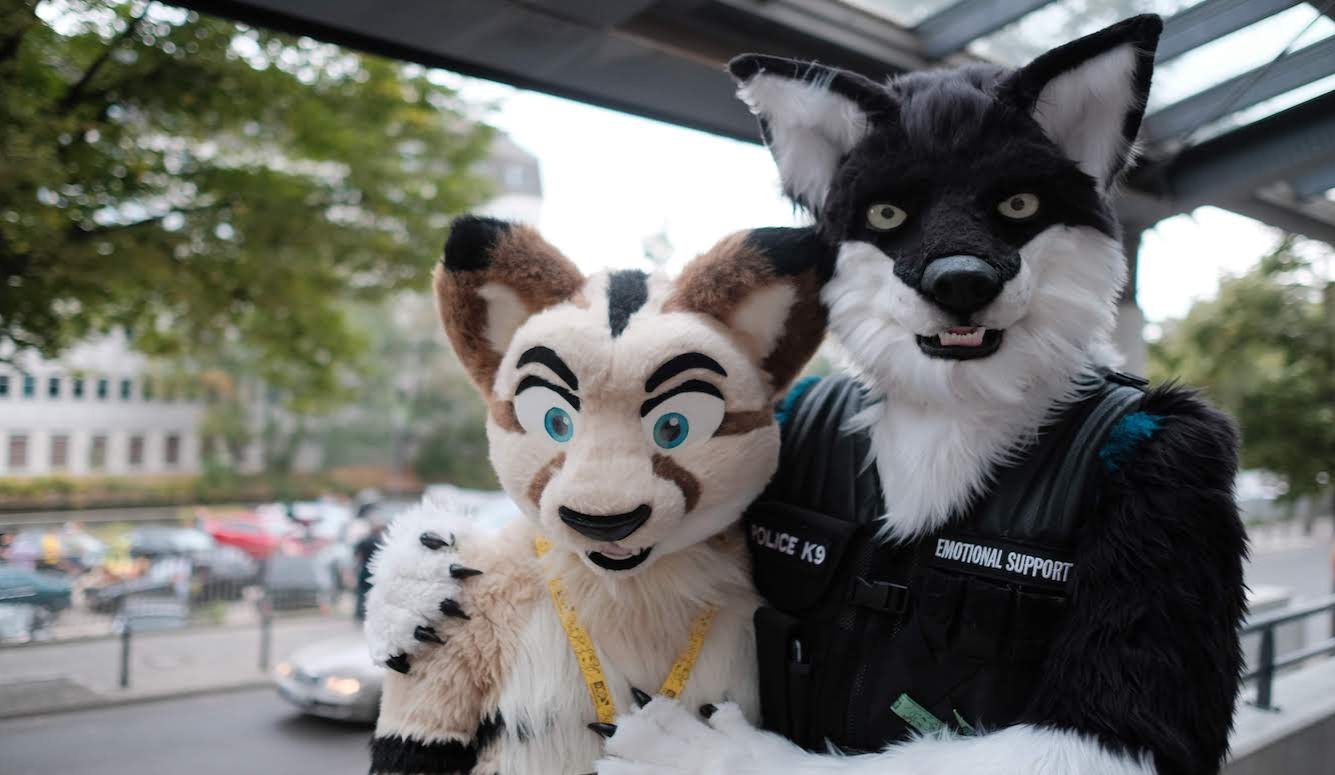Transgenderism
Affirming Your Inner Fursona
For some, gender transition is just a way station en route to more exotic (and furrier) trans-species identities.

Hallowe’en has now been and gone, but when he, she, and zie opened their doors to trick-or-treaters on October 31st, the truly woke distributor of candy would hopefully have been aware that the gaggle of youths dressed up as werewolves may not simply have been wearing playful furry disguises. In some rare cases, rubber wolf-masks could have been an external expression of their true internally experienced identities as moon-baying, trans-species wolf-people.
On October 28th, just in time for the spooky holiday season, the Federalist revealed a Colorado school district’s apparent cover-up of a wave of children in local classrooms self-identifying as full-blown humanoid animals. The previous month, Heidi Ganahl, the state’s (unsuccessful) Republican candidate for governor, had blown the (wolf) whistle on the phenomenon, leading to her immediately being accused of spreading lies by Democrats and reporters. Yet Ganahl’s comments seem to be supported by newly released emails that circulated among officials at Jefferson County School District (which includes the wealthy Denver suburb of Lakewood). Those emails—shared with the Federalist by the parental rights group Jeffco Kids First, which had obtained them under the Colorado Open Records Act—indicate that district officials had in fact received complaints from distressed parents, who complained that children were turning up to class wearing clip-on animal ears as part of their animal “fursonas,” and disrupting lessons by barking and meowing, with the seeming acquiescence of teachers.
Notwithstanding efforts to cast Ganahl as a liar, the emails suggest that fursonas at one school were creating such a barnyard atmosphere that the leadership team actually stepped in to ban such animal accoutrements. Nevertheless, because cat- and dog-identifying individuals are now classed as a niche (albeit “contentious”) subset of the ever-expanding LGBTQ community, critics seized upon Ganahl’s supposed lies to paint her as a culture-war extremist stoking febrile social panic.

To be clear: some stories along these lines have been debunked as hoaxes—such as the infamous one about Michigan schools providing litter boxes for students who self-ID as cats. But apparently real-life guides for school counsellors hoping to create safe spaces for animal-children do exist online. And Pennsylvania’s Bryn Mawr College has directed students to a long list of invented pronouns for those who self-identify as teenage werewolves, robots, mermaids, dragons, or spiders in human disguise.
It should be said that even activists can’t agree on whether those with fursonas—or “furries,” as they are sometimes more generally known—are really part of the LGBTQ sphere. Some furries are simply interested in dressing up, or innocently paying homage to a favoured fictional animal character in a book or movie. For others, there’s more of a sexual or even spiritual aspect—a channelling of some inwardly felt identity that may be directly analogized to the concept of gender identity. As one moves from the former group of hobbyist cosplay enthusiasts to the latter group of highly immersed fur fetishists, the werewolves’ claim to being part of the LGBTQ (or should that be LGBTQW?) umbrella grows stronger.
Among scholars operating on the leading edge of the queer-studies movement, there is an increasing trend toward pseudo-academic essays with titles such as Marisa Mercurio’s Queer Moon Rising, in which the expert in 19th-century Gothic fiction reports with great certainty that “a werewolf is something ineffably queer,” and a shape-shifting embodiment of “intersectional identities” whose “transformations demonstrate the malleability of bodies and their meanings.” It need scarcely be added that these rainbow lycanthropes also “destabilise gender and eschew sexual binaries.” For the author of A Grimace of Sharp Teeth: Exploring the Trans Werewolf, “the werewolf, among its many meanings and allegories, is a trans man,” and, therefore, “for me … is something that is deeply relatable … The story of the werewolf is me, [as] seen through the eyes of the world at large. What a horror that is.”
Jaquelin Elliott of the University of Florida—whose dissertation examines “queer-coded monsters in horror and fantasy fiction and the reclamation of these monstrous figures on the part of the queer community”—has expanded on related themes in her in-depth study of paranormal romance in gay fan-fiction. She describes how straight werewolves from the Harry Potter and Teen Wolf franchises have been reclaimed—somewhat arbitrarily, by my reading—as queer (often by writers who see JK Rowling’s failure to include explicit male-on-male werewolf love as yet more evidence of her highly problematic nature). Indeed, Elliott concludes that the entire traditional horror genre is saturated with insufficiently developed “articulations of queer monstrosity.”
With their purportedly serious debates about whether or not imaginary werewolves from kids’ books are actually gay or trans, today’s academics and activists are unwittingly imitating the medieval theologians and philosophers of yore who debated how, precisely, the mechanism of a man turning into a wolf was actually supposed to work (not to mention the best way to determine which villagers were secret werewolves, and which ones just had a lot of back hair).
Holding the delusion that you are a werewolf is today classified under a mental disorder known as lycanthropy, whose etymology can be traced back to the Greek lukos and anthrōpos (wolf and man respectively). Sufferers of this (generally transient) malady do not always think they are wolves specifically; there are people out there who have considered themselves everything from were-bears to were-crocodiles, even were-gerbils and were-bees. In some cases, the condition appears in individuals who report being demonically possessed as punishment for some past indiscretion, or who are genuinely psychotic. When the phenomenon presents as epidemic, it may be analysed as a culture-bound syndrome, whereby the choice and significance of the imagined animals reflect the specific social context in which the deluded individuals operate.

Such culture-bound factors were at play across Renaissance Europe: Accompanying the European witch trials of the 16th and 17th centuries was an outbreak of less well-known werewolf trials, which could end in death for the accused. Thanks to the intellectual influence exerted by leading authorities—namely, the church, and the scholars and jurists who took their cues from its priestly teachings—a surprisingly large number of mentally ill individuals came forward (or were pushed forward by others), seizing on Church pronouncements to self-validate their own adopted fursonas (avant la lettre). Alas, the resulting process of “affirmation” turned out to be quite a lot more grim and bloody than today’s coming-out parties and pronoun announcements.
Today, secular priests—in the form of ideologically driven professors and psychiatrists—perform similar acts of epistemic witchcraft. And like priests of old, they’ve put the villagers on notice that all sorts of wondrous creatures with exotic spirits walk among us. These woke clerics channel a world in which spirits and phantoms are made solid, opening the door to full-blown trans-speciesism.
In January 2022, a transgender American female-identified “otherkin” (a human who identifies as not entirely human) who’d adopted the name Naia Ōkami appeared on the UK daytime TV show This Morning, claiming to possess a “spiritual and psychological identification as a wolf” (specifically, a wolf from the Canadian province of British Columbia). Whilst recognizing that it’s impossible to literally shape-shift, Ōkami nonetheless described the practice of donning a wolf face-mask, running about, and howling in the woods near Seattle.
Ōkami’s fantasies began with “dream-shifting,” whereby Ōkami dreamt of seeing the world through a wolf’s eyes. One media account describes this as an early symptom of a “trans-species dysphoria of the soul.” But it’s hard to overlook the fact that this kind of “dream-shifting” into a wolf’s consciousness is a central plot element in George R.R. Martin’s A Song of Ice and Fire book series (of which A Game of Thrones was the first instalment). Indeed, it is notable that many of the most active members of trans (both gender and species) subcultures tend to draw influences from science fiction, sword and sorcery, cyberpunk, anime, and other imaginary realms.

Ōkami, it is worth noting in this regard, is the name of a classic PlayStation2 role-playing game, in which the player controls the Japanese sun-goddess Amaterasu, whose spirit descends to Earth in the shape of a—you guessed it—white wolf. So what we seem to have is a man, presenting as a woman, pretending to be a Japanese sun-goddess, role-playing as a wolf from a videogame.

From what I can tell, otherkins tend to be troubled individuals who often begin their role-playing as plain old transgender, but then progress to the conceit that they are spiritually (or even physically) channelling the souls of animals, supernatural entities, mechanized creatures, or even inanimate objects. One 2020 investigation into otherkin culture, published at Daily Dot, featured such beyond-parody descriptions as “Kasi Frost is a fox, an elf, an object and a doll/robot, along with ‘blends’ of these identities together, who uses nouns instead of pronouns.” In keeping with the modern zeitgeist, the author lauded these “unapologetic weirdqueers” for their discomfort “with being read as human,” even claiming that they are “our future.”
And while some may be tempted to dismiss this sort of subculture as a marginal curiosity, it should be remembered that—as with many such movements—there have emerged demands that animal-, robot-, and doll-identified “weirdqueers” should have access to their own quixotically defined set of guaranteed human rights (even if, by their own insistence, the term human is a misnomer).
In the style of early transgender advocates, otherkins are now banding together into clubs with names such as The Alterhuman Advocacy Group (aka ALT + H, dedicated to “increasing awareness and acceptance of afterhuman people”) and The Freedom of Form Foundation, whose more explicitly medical mission is to lobby doctors, academics, and politicians so that “otherhearted people and selfshapers” can employ “biotech for self-expression.” The first step—and again, the gender movement provides a template—is to remove the stigma surrounding lycanthropy (and co-morbid conditions such as schizophrenia and depression), so that it may be relabelled as a mere expression of one’s “authentic” self.
Moreover, the polyamorous movement might be taken as a forerunner for those otherkin activists who seek acceptance for the (not-at-all-bizarre) idea that one may have “a collection of entities sharing a body.” Please don’t use real clinical terms such as dissociative identity disorder to describe these individuals. Nope, they’re just people “who experience plurality”—like Dr. Jekyll and Mr. Hyde.
In 1977, the American Journal of Psychiatry reported on the case of a 49-year-old female lycanthrope from Texas who suffered recurrent psychotic episodes in which she felt Satan enter her body and transform her into a wolf—at which point she would begin growling, strip naked on all fours, and begin offering herself sexually to all comers, irrespective of her prospective mate’s gender, species, or family relation. She dreamed about wolves, too, providing further “evidence” (as she saw it) that she actually was one. She would gaze into a mirror and literally see a wolf’s head up there snarling on her shoulders; this was who she really was, down in the depths of her soul. Could her doctors not see this?
Thankfully not. They hospitalised her on an urgent psychiatric basis until symptoms subsided. But if bodies such as The Alterhuman Advocacy Group hold sway, the outcome in a similar modern case could be quite different. Such individuals’ lycanthropic fursonas must be affirmed, some would demand, as a matter of principle. Indeed, perhaps we aren’t far from a time when the distinction between human and wolf is itself dismissed as a “false binary.” Who’s to say where one category begins and the other ends?
We already live in an age when girls who cut their hair short and don’t like dresses are asked if they would secretly like to be a boy. How long before innocent toddlers playfully pretending to be Pikachu are reminded that it’s perfectly okay to be a dyed-yellow trans-Pokémon who hangs out with the other “weirdqueers”? And while werewolf self-identification is not yet a protected characteristic under any nation’s law, such a development isn’t much more far-fetched than certain legal farces we’ve already witnessed.

Consider, for instance, the case of Daniel Eastwood, a man who’s currently serving a life-sentence for murder in a Scottish women’s prison, having changed his identity to that of “Sophie Eastwood” in 2018. Yet this is not enough: Sophie now wishes to further self-ID as a small (female) baby, and is demanding that guards change her diaper, mush up her food, and escort her from her cell by holding hands. As one media source dryly put it, however, “the Scottish prison service has no protocol in place for dealing with prisoners who decide they are babies.” So whilst jail bosses ponder Eastwood’s request, the interim compromise measure has been to issue Li’l Sophie with a pacifying dummy to suck.
Stay tuned. If Sophie decides she’s actually a baby female werewolf cub, tragically trapped within the body of an adult male murderer, then—who knows?—maybe she can spend the rest of her sentence in the zoo.






